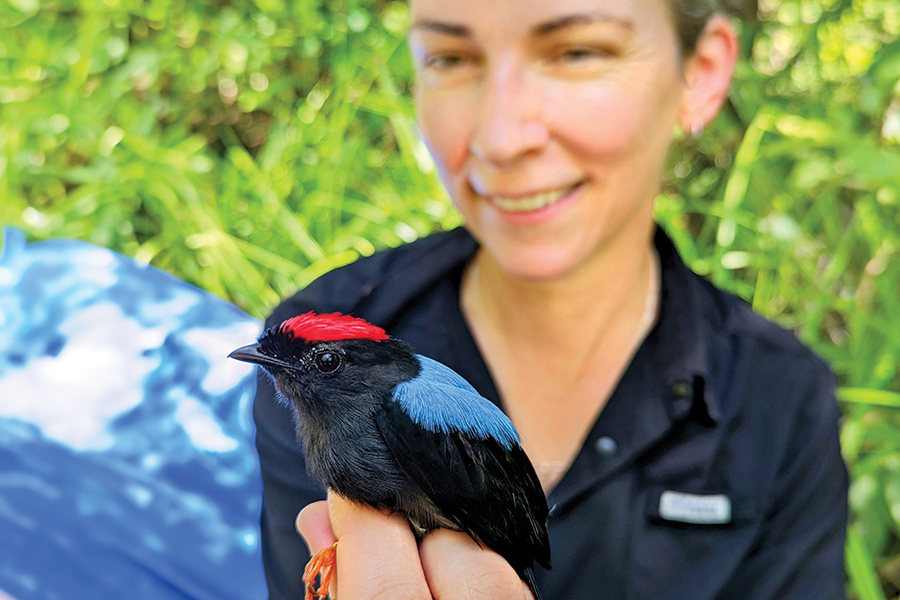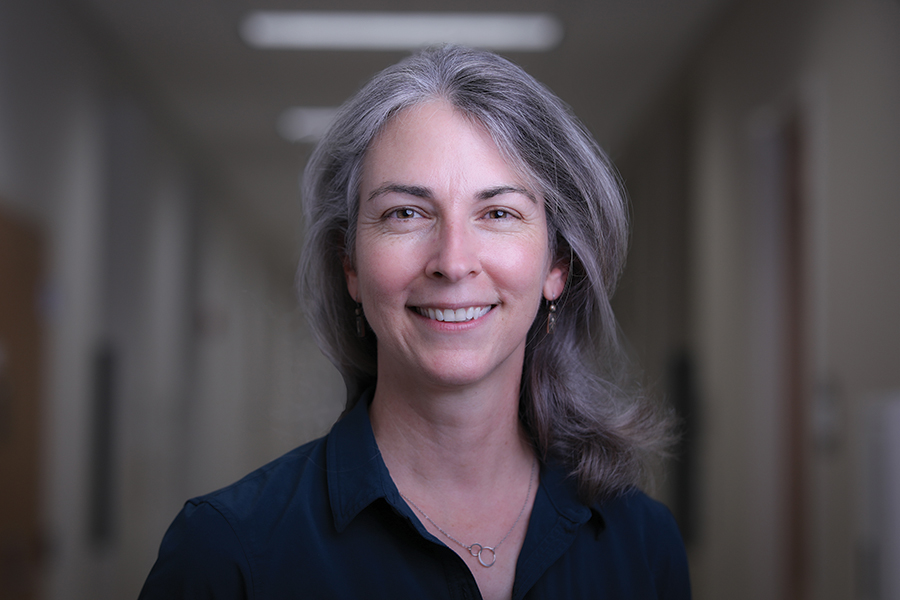A Bird’s Life
Biologist Emily DuVal investigates complex rituals of lance-tailed manakins and what such animal behaviors can mean for human relationships

In today’s age of dating apps, the average person has likely swiped through hundreds of profiles looking for a match. Whether it’s someone’s eyes or smile, such characteristics intrigue potential partners and can be the spark for a lifelong partnership.
In the animal kingdom, mate selection can be just as challenging. Instead of swiping on Tinder, OkCupid or Match, however, animals rely on complex rituals to select mates based on chosen characteristics, and birds, including the lance-tailed manakin, put on some of the most exciting mating displays in nature.
These compact birds, just about five inches long, are found in the forests of Central and South America, and male manakins are marked by their red cap and blue cape on an all-black body. Their unique mating ritual involves one male manakin repeatedly jumping over a cooperating male partner — a wingman — to attract the interest of a female.

Florida State University professor of biological science Emily DuVal has spent nearly three decades studying these birds while investigating the underpinnings of sexual selection, the process through which animals choose mates. Her work cultivates a deeper understanding of how manakins make mating decisions, engage in cooperation tactics, and form alliances to ensure survival of their species. What she’s learned can help explain, on a simplified scale, human relationships.
“Animals do amazing things and lead lives filled with complicated social interactions,” DuVal said. “We’ve discovered birds have neighbors, partners and family, and some birds have rich individual histories like us. As I learn more about how these birds’ decisions produce patterns in the wild, it raises questions about why animals behave the way they do in all their beautiful complexity.”
Research on sexual selection has often focused on flashy traits and behaviors in male birds. While the flamboyant males’ displays factor into female manakins’ mating decisions, they may not be the sole criteria. DuVal’s research team has found that male birds’ age, experience, and proximity to their neighbors are important for mating success, but some of the team’s main insights stem from investigating the female birds' perspective, such as how they assess male birds and how their search behavior changes as they age.
“I originally wanted to become a veterinarian, but I quickly realized animals visiting the vet were not happy. I wanted to experience and study animal behaviors in their most natural states because that's when they teach us most about ourselves.”
— Emily DuVal
“In part inspired by the intricacies of manakin relationships, my team developed a mathematical model, Inferred Attractiveness, that proposes a new idea about how females choose mates,” DuVal said. “We suggest females learn from each other’s mate choices but use the context of other males to decide what makes a chosen male attractive. Because observing females aren’t mind-readers, they can make ‘mistakes’ in inferring what traits are important, and this generates some interesting patterns over time. This model is designed to explain why our observations don’t always match up to current theories, which for example suggest ‘good’ genes drive mate choices in many species.”
DuVal, who is also 2023 president-elect of the Animal Behavioral Society, a non-profit scientific society founded to encourage and promote the study of animal behavior, publishes collaborative works using high-quality data that tell a story about lance-tailed manakins for future work in genetic differences among bird species.
She has returned to the same field site to track individual manakins for the past two decades, and she plans to collect another 10 to 15 years worth of data with the goal of establishing one of the most complete evolutionary studies on bird mating behaviors, which can offer potential insights into the human sexual selection process.



“I originally wanted to become a veterinarian, but I quickly realized animals visiting the vet were not happy,” said DuVal, who earned a doctorate in animal behavior in 2005 at the University of California, Berkeley before joining FSU’s faculty in 2008. “I wanted to experience and study animal behaviors in their most natural states because that's when they teach us most about ourselves.”
DuVal is also committed to helping up-and-coming biologists match with opportunities that will allow them to pursue their own lines of research. While at Berkeley, she funded her doctoral research via the National Science Foundation Graduate Research Fellowship Program, among other sources, and she illuminates the program’s funding process for her own doctoral students and others as cohost of FSU’s annual NSF GRFP workshops.
“I love working with Dr. DuVal. Our collaboration has involved how to develop research questions and hypotheses, as well as mastering the art of expressing them within grant applications,” said doctoral student Pearl Rivers. “She has been an unwavering pillar of encouragement throughout my graduate school experience.”
Hannah Fulk is an FSU alumna who earned a bachelor’s degree in public relations in 2022. She is currently pursuing a master's degree in media and communications studies with a certification in digital video production and is set to graduate in May 2024.

